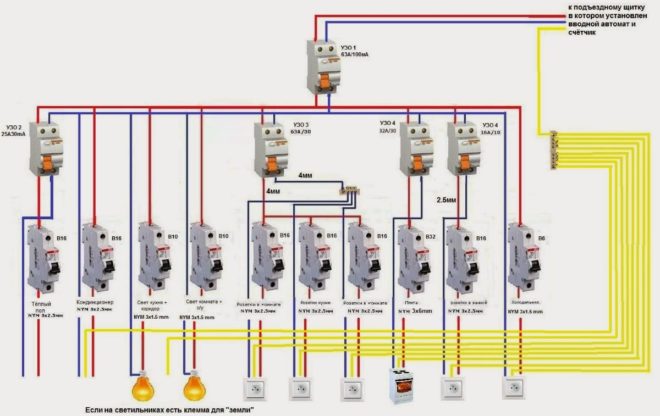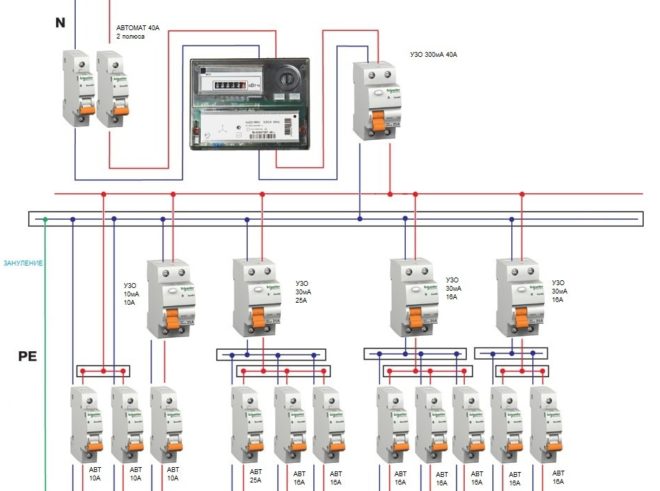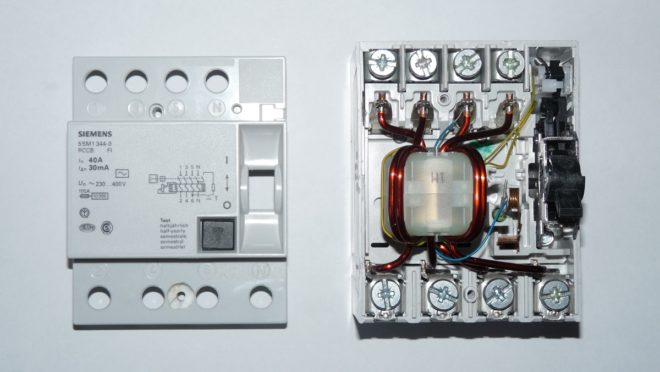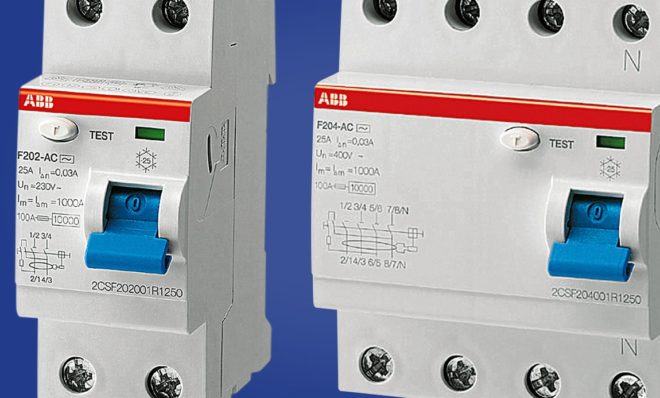RCD selectivity - what is it?
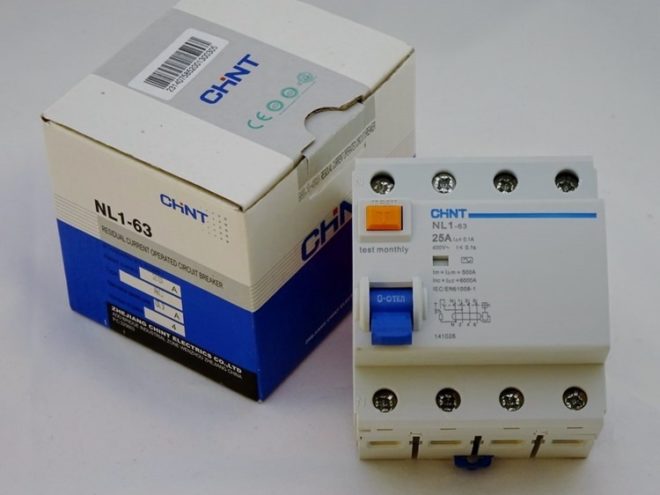
Many are familiar with the residual current device (RCD). The modern electrical network is not complete without this element of protective automation. The main purpose of its installation is to protect a person from the effects of electricity and from fires caused by current leaks. Such emergencies can occur due to worn out old conductor insulation or poor-quality wiring connections. In order to detect such accidents in time and prevent them from escalating into fire or electrical injury, protective shutdown devices are installed. When installing a two-level protection, a selective RCD is used. What is this device? How does it differ from ordinary? What other types and types of RCDs are there? Below we will answer all these questions.
Content
What is selectivity?
The main goal of selectivity is selectivity, that is, the protective automation selects only the damaged area and cuts it off from the working network. At the same time, unwanted blackouts of other consumers must be excluded.
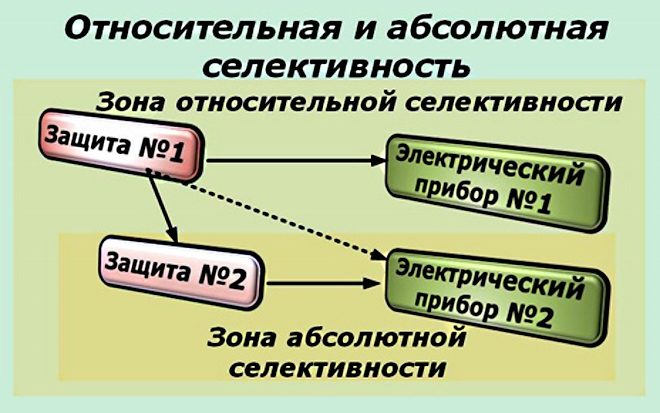
To make it clear to you, consider this with a simple example.
To ensure selectivity, the protective automatics in the switchboard are connected in series according to the following scheme:
- After the introductory machine, a general selective RCD is installed at the input.
- Also, several separate residual current devices are installed as group protection. Here the schemes may vary. There is an option to install an RCD separately for each room. You can separate the protection for the outlet and lighting groups. Most often, a scheme is used when a separate residual current device is installed for each element of powerful household appliances (water heater, washing machine, electric oven, air conditioner).
An introductory selective RCD must have a certain time delay (from 0.06 to 0.5 s).
Clearly about the selectivity of the RCD in the video:
If an emergency occurs in the washing machine, for example, insulation breakdown, then a certain potential will appear on its body. When the apartment has a three-wire electrical network, that is, there is a protective grounding, the RCD will react immediately and by disconnecting it will stop supplying power from the network to the washing machine. In the case of a two-wire network (without protective grounding), the RCD does not react in any way to this situation until a person touches the body of the washing machine.
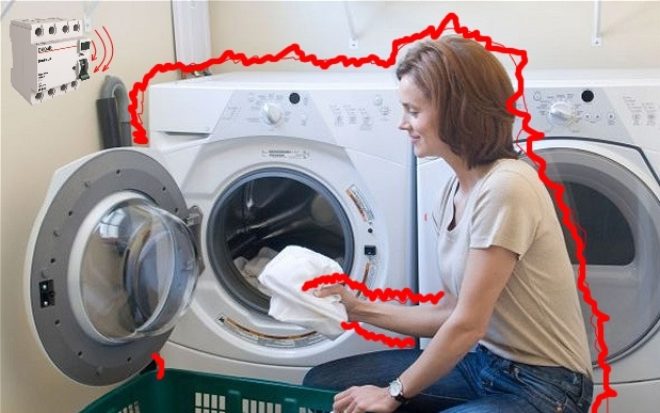
At this point, it will begin to play the role of a conductor for the current leakage to earth, and then the device is turned off.
Selectivity in this situation lies in the actuation of an RCD, which is closer to the place of damage, that is, a group RCD that protects the machine. The input device must remain in working position. This is the principle of selectivity. Thus, selectivity allows you to do with minimal losses, that is, only the washing machine remains de-energized, all other equipment in the apartment continues to work. Also, due to selectivity, it is easier to find the damaged area - which RCD has turned off, in that group there is a malfunction.
Selective work
To ensure the selectivity of several RCDs connected in series, they must be correctly selected according to the values of current and time. The main role is played by such RCD parameters as time and current settings. These devices differ from the rest of the automation in that their selectivity can be set not only by the time value, but also by the current.
Based on the time interval, a selective RCD has two types:
- Type "S" with a time delay of 0.15-0.5 s.
- Type "G" with a time delay of 0.06-0.08 s.
Please note that a conventional RCD without a selectivity function trips 0.02-0.03 s after detecting a leakage current. Such a device is installed for outgoing group consumers, and type "S" or "G" is suitable for installation at the inlet (close to the power source).
The way to ensure the selectivity of the RCD on the video:
Remember that the upstream RCD must have a three times longer time delay than the devices protecting the outgoing lines. A similar difference is needed in the variant when the selective operation is built according to the rated residual breaking current. This value at the input device should be three times higher than the group protection current.
To put it simply, the input RCD, when a leak occurs, fixes the difference in the values of the input and output currents, but does not react. It kind of makes it possible for downstream devices to work. And only if, for some reason, these devices did not work (due to a breakdown of the RCD itself or errors made when switching the circuit), after a certain time the selective RCD at the input will turn off. It is a kind of safety net for group devices.
There is another case when the input device will work - if a current leak occurs between it and the group RCD located below. To make it clearer, let's explain with an example. Suppose the input device, together with an electricity meter and a general automatic device, are mounted in a switchboard located on the street. And devices for outgoing lines are installed in a switchboard, which is located inside the house. If a current leak occurs on the cable between these two shields, then the selective RCD at the input will react and turn off.
Selectivity - good or bad - in the video:
Classification of devices according to the form of current leakage
Almost all characteristics are displayed on the housings of the residual current devices. It indicates the nominal parameters, wiring diagram and some alphabetic characters. We have already discussed above what the English letters "S" and "G" mean, and what characterizes the designation "B", "A" and "AC"? This RCD marking means different forms of current leakage to which the device reacts:
- The AC type is the most common and affordable financially. These RCDs are disabled when instantaneous or smoothly increasing sinusoidal alternating current leaks appear in the networks.
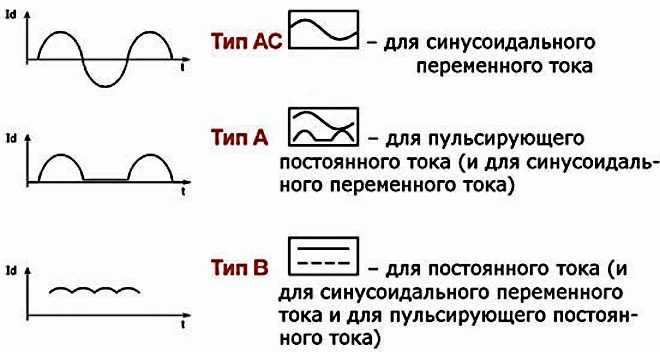
- Type "A". These devices react, as well as "AC", to sinusoidal alternating current leakage, plus also to constant pulsating current waveforms. The price of type "A" RCDs is higher due to the fact that they control not only variable, but also permanent leaks.
- Type "B". These devices are practically not used in residential apartments and houses; more often they are installed in industrial premises. They control three forms of current leakage at once: constant pulsating, rectified and variable sinusoidal.
We all know perfectly well that our household electrical network has a variable sinusoidal shape. It would seem that it is enough to install the RCD "AS", why else do we need some "A" and "B"? But if you carefully read the characteristics of modern household appliances, you will find that most of the devices are equipped with semiconductor power supplies. When the sine wave reaches this element, it is converted to a pulsed half-cycle. If damage occurs at this point, then the "AC" device will not detect a constant current leakage and will not work.
We recommend that you carefully study the passport for household appliances before you go to buy an RCD. The manufacturer often indicates through which type ("A" or "AC") the connection must be made.
Varieties of RCDs according to the principle of action
According to the principle of operation, there is an electronic and electromechanical RCD.
For the operation of an electronic device, the appearance of a leakage current is not enough; a supply network is also required. Its circuit is complemented by an electronic built-in amplifier powered by external power sources. And if for some reason no voltage is supplied to this amplifier, the device will not work. For this reason, an electromechanical RCD is considered more reliable than an electronic one, and has become more widespread.
Consider how the electromechanical RCD works and how it works. It consists of four main units: a tripping mechanism and an electromagnetic relay (they work in conjunction), the differential current transformer itself and a test element.
The opposite phase and zero windings are connected to the transformer. In the normal mode of the network, these wires contribute to the guidance in the transformer core of magnetic fluxes having opposite directions relative to each other. Due to the opposite direction, the sum of these flows is equal to zero.
The electromagnetic relay is connected to the secondary transformer winding and is at rest during normal network operation. As soon as a leak appears, different current values begin to flow through the phase and zero wires. As a result, the magnetic fields on the transformer core will now differ not only in direction, but also in magnitude. The sum of the magnetic fluxes is no longer equal to zero. The current that appears in the secondary transformer winding at a certain moment reaches the value at which the electromagnetic relay operates. Accordingly, the trip mechanism will immediately react and the RCD is disconnected.
Still, mechanics are still more preferable than electronics, so when buying, choose an electromechanical RCD.
Useful tips for choosing devices
- When choosing, keep in mind that there are also types of RCDs that are different in design. Devices with two poles are mounted in a single-phase network, for a three-phase one should choose an RCD with four poles.
- If financial possibilities allow, then it will be more expedient to use differential automata. This device consists of two protective elements combined in one housing (RCD and circuit breaker).
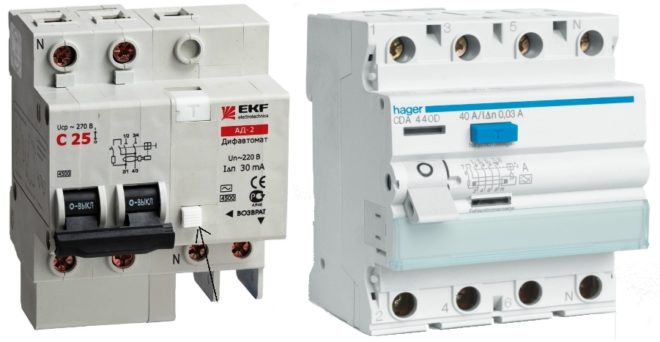
As already mentioned many times, the residual current device should always be installed in the circuit in series with the machine. If you install them for each individual consumer, then the switchboard will turn out to be large, it will be inconvenient to arrange such a number of elements in it, and the difavtomats will need half as many.
- You will find a description of almost all the characteristics of the device on the case. When choosing, you should pay attention to the parameters of the rated operating current - the value that the RCD passes through itself for a long time. The second important characteristic is the magnitude of the rated residual current at which the device operates.
To ensure the protection of people, choose an RCD for 6, 10, 30, 100 mA. A 300 mA RCD will effectively protect against fires, it is mounted at the input, and only then devices with greater sensitivity are installed. You can protect the outlet and lighting groups using a 30 mA RCD; for bathroom equipment and powerful household appliances (boilers, boilers), buy devices with a rated shutdown current of 10 mA.
- If finances permit, try to purchase devices from well-known European companies (ABB, Legrand, Schneider Electric, Siemens and Moeler). The difference in price, of course, is tangible, but it guarantees reliability and quality. Among the Russian manufacturers, one can recommend the products of "KEAZ", "IEK", "DEKraft". Do not buy an RCD on the market, in order to avoid purchasing fakes, go only to specialized stores.
Read more about the choice of RCDs in the video:
Before starting the installation of protective automatics in an apartment, decide with the help of which devices you will do this - difavtomats or RCDs. For reliability, use a two-level protection with a selective device installed at the input. We have provided you with basic advice on choosing. If something remains unclear, then it is better to seek help from professional electricians, because even sellers in electrical stores cannot always give the necessary advice in terms of choosing an RCD.

